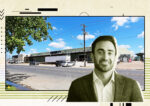Competition to become Austin’s next hot neighborhood is always fierce, but in 2015, St. Elmo seemed ready to snatch the crown.
About three miles south of Lady Bird Lake, St. Elmo was well-positioned between downtown Austin and the booming suburbs to the south. It mixed cutesy old homes with shabby-chic warehouses ready for conversion into creative offices and breweries. Through a mix of development and conversions, developers saw a way to build a destination neighborhood on those sturdy bones.
The centerpiece would be St. Elmo Public Market. GroundFloor Development, along with partners including Carlin Company and Fenix Global Investments, planned to build a 42,000-square-foot bazaar at 4329 South Congress Avenue, modeled after Seattle’s Pike Place Market.
It promised to bring an all-star lineup of local restaurants to the heart of a massive mixed-use development with hotel, office and residential space. It would be a catalyst, the type of place that establishes a neighborhood and spurs even more development around it.
But after the developers announced the market in 2015, they delayed it. Then they delayed it again and again. Between 2016 and 2019, moreover, the principals of GroundFloor were embroiled in a lawsuit accusing each other of wrongful termination and embezzlement, respectively. By 2019, all the relevant parties had settled, just in time for the pandemic to throw markets into a tailspin.
There comes a time in every gentrifying neighborhood’s life when it gets an arcade bar. (Williamsburg, Brooklyn opened a Barcade in 2004. Pilsen, a trendy Chicago neighborhood, fought against a Headquarters Beercade in 2021.) After eight years of hype, that time has come for St. Elmo.
Real estate investment firm SomeraRoad bought the building last year and leased it to a duckpin bowling bar.
While not the neighborhood anchor that the public market may have been, this bar is nonetheless a step forward for the neighborhood’s retail and dining scene. It’s part of a much larger push by developers who have land banked and plans underway to finally turn St. Elmo into a true live-work–play neighborhood, after nearly a decade in the spotlight.
St. Elmo’s dominant development is the Yard. It’s a sprawling collection of warehouses totaling 200,000 square feet of manufacturing and retail space. The tenant mix leans bubbly: in one strip, tenants include the Austin Winery, Austin Cocktails, Blue Norther Hard Seltzer, Texas Saké Company, Still Austin Whiskey and St. Elmo Brewing Company.
Still, the Yard has plenty of non-alcoholic tenants. Icon, the construction technology company leading the way in 3D-printed homes, is based out of a huge building there and operates a research and development unit there too. There’s also a gym, a coffee roaster and a flock of food trucks.
The Yard was developed by Veloway Threads, a company founded by Adam Zimmerman and Merrick and Scott Ungar. It is perhaps the largest owner of St. Elmo development sites. In January, the company announced that it had purchased fourteen properties in the area in the last year.
Priscilla Sauceda, an operations executive with the developer, said it was drawn to the neighborhood’s flexibility and the “character and charm” of the warehouses.
“We compare the ultimate vision to Wynwood in Miami,” Sauceda said, referring to the colorful, mural-laden neighborhood known for its galleries and shopping.
The company has not done much ground-up residential development, and is largely focused on commercial work. It may sell or bring on a partner to develop some land it owns that is mixed-use residential, according to Sauceda.
For all the development of the Yard, much of St. Elmo still feels industrial, not warehouse-chic.
“There’s been a little bit of a stutter-start feeling, if you ask the average person about the area,” Sauceda said. “There are some people who still don’t know what part of town this is in.”
But Veloway Threads expects that to change soon. The company plans to finish out its vision for the neighborhood within the next five years.
One of the biggest projects set to change that identity is the Bergstrom Spur Trail, which will pedestrianize 6.5 miles of former railroad connecting South Congress Avenue to Austin Bergstrom Airport.
A stretch of that trail will run directly along the north end of St. Elmo near Industrial Boulevard, greatly improving the walkability and development value of a stretch of warehouses owned by Connecticut and Austin-based Leifer Properties.
“It has the bones to be a walkable neighborhood,” said Max Leifer, a principal at the firm. “We like that it kind of has confined geographic borders, and can’t really sprawl out.”
Unlike other neighborhoods in Austin that have continuously sprawled, St. Elmo is penned in by Highway 290, Interstate 35 and South Congress Avenue, encouraging developers to build up rather than out.
As Austin grows, some city officials and activists are pushing for greater density, to mixed success. With citywide reforms bogged down in process, developers have moved to implement some of those same urbanist principles on a neighborhood-by-neighborhood basis. Those projects, like the Domain in north Austin, have highlighted a more scattered approach to density.
“The city has grown so much that not everybody wants to go all the way into downtown anymore,” Sauceda said. “So how can we create these hubs and little pockets elsewhere in the city that cater to the folks that are located closer to those areas?”
Leifer is in the process of securing rezonings for warehouses it owns at 300-440 Industrial Boulevard and 560-600 Industrial Boulevard. It plans mixed-use developments with up to 1,000 apartments, retail space and offices, Leifer said.
At the same time, Redcar Properties is working to score a mixed-use rezoning for a small shopping center it owns at 4201 South Congress Avenue.
Outside of a few notable apartment buildings, most of the housing in the St. Elmo area is single-family detached homes.
That is changing, albeit slower than some envisioned. Bishop Momo, United Properties’ multifamily development at 4341 South Congress Avenue, will bring 274 apartments to the neighborhood when it’s finished later this year. It joins a handful of other apartment buildings on the South Congress side of the neighborhood, including 44 South and Congress Lofts.
“The neighborhood was almost built on what would have been the public market,” Leifer said, noting it’s one of the reasons his firm started buying there. Despite the loss of that project, he still sees changes coming.
“In just one or two years, the neighborhood is going to be entirely different.”
Read more



